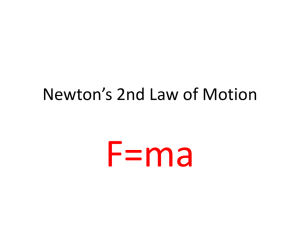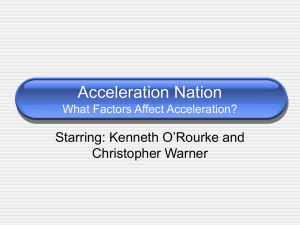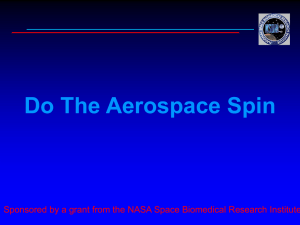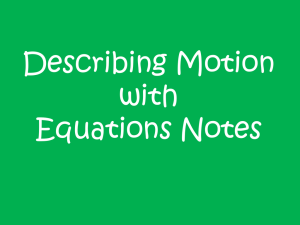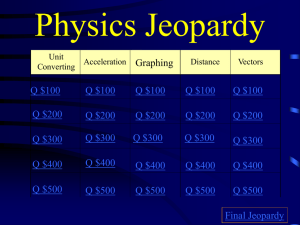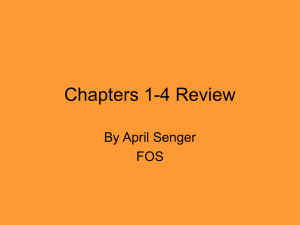4.3 Acceleration Acceleration describes how quickly speed changes
advertisement
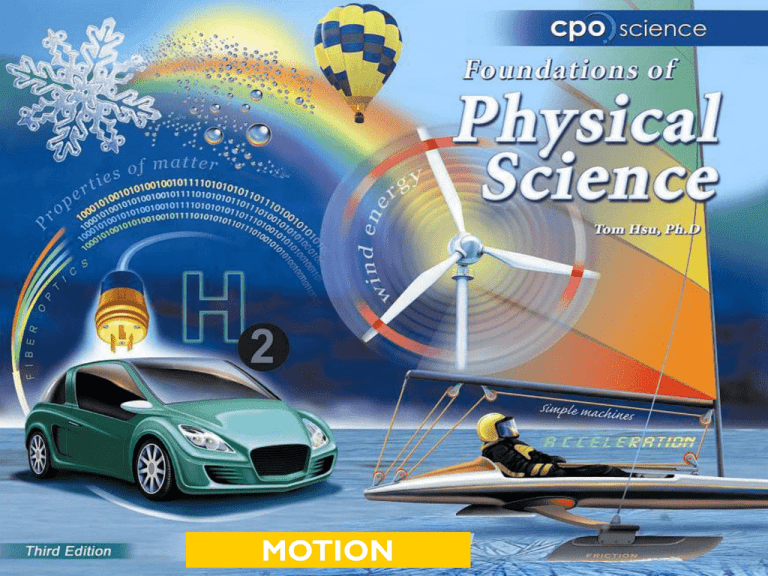
MOTION 4.3 Acceleration Acceleration is the rate at which your speed (or velocity) changes. 4.3 Acceleration What is the bike’s acceleration? 4.3 Acceleration Acceleration describes how quickly speed changes. Acceleration is the change in speed divided by the change in time. 4.3 Speed and acceleration An acceleration of 20 km/h/s means that the speed increases by 20 km/h each second. The units for time in acceleration are often expressed as “seconds squared” and written as s2. Can you convert this rate using conversion factors? Solving Problems A sailboat moves at 1 m/s. A strong wind increases its speed to 4 m/s in 3 s. Calculate acceleration. Solving Problems 1. Looking for: …acceleration of sailboat 2. Given: …v1 = 1 m/s; v2 = 4 m/s; time = 3 s 3. Relationships: a = v2 – v1/t 4. Solution: a = (4 m/s – 1 m/s)/ 3 s = 1 m/s2 4.3 Acceleration on speed-time graphs Positive acceleration adds more speed each second. Things get faster. Speed increases over time. 4.3 Acceleration on speed-time graphs Negative acceleration subtracts some speed each second. Things get slower. People sometimes use the word deceleration to describe slowing down. 4.3 Acceleration on position-time graphs The position vs. time graph is a curve when there is acceleration. The car covers more distance each second, so the position vs. time graph gets steeper each second. 4.3 Acceleration on position-time graphs When a car is slowing down, the speed decreases so the car covers less distance each second. The position vs. time graph gets shallower with time. Increasing positive velocity (positive acceleration) Decreasing negative velocity (negative acceleration) Different Position. Vs. Time 4.3 Free fall An object is in free fall if it is accelerating due to the force of gravity and no other forces are acting on it. Free Fall Free fall is a state of falling, free from air resistance and other forces except gravity. NO Air resistance, no drag, no friction Free Fall????? Acceleration Due to Gravity Galileo Galilei recognized about 400 years ago that, to understand the motion of falling objects, the effects of air or water would have to be ignored. As a result, we will investigate falling, but only as a result of one force, gravity. Galileo Galilei 1564-1642 Galileo’s Ramps Because gravity causes objects to move very fast, and because the time-keepers available to Galileo were limited, Galileo used ramps with moveable bells to “slow down” falling objects for accurate timing. 4.3 Free fall Falling objects increase their speed by 9.8 m/s every second, or 9.8 m/s2 Guinea Feather and Coin/NASA demonstrations 4.3 Acceleration and direction A car driving around a curve at a constant speed is accelerating because its direction is changing. 4.3 Curved motion A soccer ball is an example of a projectile. A projectile is an object moving under the influence of only gravity. The path of the ball makes a bowl-shaped curve called a parabola. Projectile Motion Projectile Motion and Gravity Projectile motion is the curved path an object follows when thrown or propelled near the surface of the earth. Projectile motion has two parts, or components, horizontal and vertical These two components are independent of one another; that is, they have no effect on each other Fountain at ¡Explora! Science Museum, Albuquerque, NM Horizontal motion…. …+ Vertical = parabolic path 4.3 Curved motion Circular motion is another type of curved motion. An object in circular motion has a velocity vector that constantly changes direction. Moving in Circles When an object moves in a circle, its direction is constantly changing If its direction is changing, its velocity must also be changing, and it must be accelerating If the object is accelerating, there must be a force causing the acceleration. Centripetal Force …is applied by some object. Centripetal means "center seeking". Centrifugal Force …results from a natural tendency. Centrifugal means "center fleeing". What happens if the accelerating force is removed? Factors affecting Centripetal Force Radius or rotation Smaller radius requires greater force Speed of rotation Faster rotation requires greater force Mass of object Larger mass requires greater force


